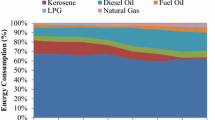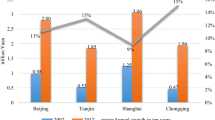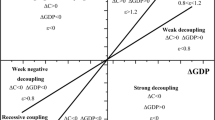Abstract
As a major contributor of carbon emission in the world, China should focus on the balance between the universality of development and regional heterogeneity of carbon discharge during the transformation toward low-carbon economy. To reveal the differences among interprovincial industry energy’s carbon emissions, some relevant data of carbon emissions in 29 provinces and municipalities during the period of 1996–2012 are selected in this study. Based on the Logarithmic Mean Divisia index decomposition model and hierarchical clustering method, the 29 provinces were clustered in turn by four time intervals according to some indicators, including economic intensity, energy intensity, industry structure, energy structure, demographic effect, and carbon density influence. Research results show that during 1996–2000, economic intensity has a strong positive driving effect on carbon emissions in such eastern provinces as Shanghai, Zhejiang, and Jiangsu, and other seven inland provinces, such as Hunan and Hubei. Demographic effects have strong pulling effects on carbon emissions in municipalities and eastern coastal provinces, and they also exert strong negative effects on carbon emissions in Anhui, Guangxi, Guizhou, and Sichuan in the first three time intervals. During the four periods, highly energy-efficient provinces are Jiangsu, Guangdong, Sichuan, Shandong, Hubei, etc., whose carbon emissions are significantly inhibited by their energy intensity, whereas inefficient provinces are concentrated in western regions, like Guangxi, Hainan, Gansu, Qinghai, Ningxia, Xinjiang, etc.






Similar content being viewed by others
References
Ang BW (2004) Decomposition analysis for policy making in energy: which is the preferred method. Energy Policy 32:1131–1139
Ang BW (2006) Monitoring changes in economy-wide energy efficiency: from energy—GDP ratio to composite efficiency index. Energy Policy 34(5):574–582
Ang BW, Zhang FQ (2000) A survey of index decomposition analysis in energy and environmental studies. Energy 25(12):1149–1176
Ang BW, Zhang FQ, Choi K (1998) Factorizing changes in energy and environmental indicators through decomposition. Energy 23:489–495
Bi J, Zhang R, Wang H, Liu M, Wu Y (2011) The benchmarks of carbon emissions and policy implications for China’s cities: case of Nanjing. Energy Policy 39(9):4785–4794
Chang YF, Lin SJ (1998) Structural decomposition of industrial CO2 emission in Taiwan: an input–output approach. Energy Policy 26:5–12
Chen WY (2005) The costs of mitigating carbon emission in China: findings from China MARKAL-MACRO modeling. Energy Policy 33(7):885–896
Chen YA, Lin S (2015) Decomposition and allocation of energy-related carbon dioxide emission allowance over provinces of China. Nat Hazards 76(3):1893–1909
Chen L, Yang ZF (2015) A spatio-temporal decomposition analysis of energy-related CO2 emission growth in China. J Clean Prod 103:49–60
Clarke-sather A, Qu J, Wang Q (2011) Carbon inequality at the sub-national scale: a case study of provincial-level inequality in CO2 emission in China 1997–2007. Energy Policy 39:5420–5428
Cong RG, Wei YM (2010) Potential impact of (CET) carbon emissions trading on China’s power sector: a perspective from different allowance allocation options. Energy 35(9):3921–3931
CSY (1996–2012) China Statistical Yearbook, National Bureau of Statistics of China
Deng Y, Liu SH, Liu X (2014a) Spatial pattern its evolution of Chinese provincial population and empirical study. Acta Geogr Sin 69(10):1473–1486 (in Chinese)
Deng JX, Liu X, Wang Z (2014b) Characteristics analysis and factor decomposition based on the regional difference changes in China’s CO2 emission. J Nat Resour 29(2):189–200 (in Chinese)
Detlef V, Zhou FQ, Bert V, Jiang KJ, Cor G, Li Y (2003) Energy and emission scenarios for China in the 21st century-exploration of baseline development and mitigation options. Energy Policy 31(4):369–387
Du L, Wei C, Cai S (2012) Economic development and carbon dioxide emissions in China: provincial panel data analysis. China Econ 23(2):371–384
Gao X (2011) The study of key factors on targets decomposing of CO2 emission controllable targets decomposed in China. Res Rep (in Chinese)
Geng Y, Tian M, Zhu Q, Zhang J, Peng C (2011) Quantification of provincial-level carbon emissions from energy consumption in China. Renew Sustain Energy Rev 15(8):3658–3668
Grübler A, Nakicenovic N, Dept WBE (1994) International burden sharing in greenhouse gas reduction. International Institute for Applied Systems Analysis, Laxenburg
Hoekstra R, van den Bergh Jeroen CJM (2003) Comparing structural decomposition analysis and index. Energy Econ 25(1):39–64
Howarth R, Schipper L, Duerr P, Strom S (1991) Manufacturing energy use in eight OECD countries: decomposing the impacts of changes in output, industry structure and energy intensity. Energy Econ 13(2):135–142
Hu ZY, Tang LW, Su J (2015) Convergence of provincial carbon emission intensity and dynamic processes. Resour Sci 37(1):0142–0151 (in Chinese)
Huang GX, Ouyang XL, Yao X (2015) Dynamics of China’s regional carbon emissions under gradient economic development mode. Ecol Ind 51:197–204
IPCC (2006) Greenhouse gas inventory: IPCC guidelines for national greenhouse gas inventories. United Kingdom Meteorological Office, Bracknell
Li B, Liu XX, Li ZH (2015) Using the STIRPAT model to explore the factors driving regional CO2 emissions: a case of Tianjin, China. Nat Hazards 76(3):1667–1685
Liang H (2013) Characteristics and changes of floating population in Guangdong Province. Popul Dev 19(4):46–53 (in Chinese)
Lin BQ, Jiang ZJ (2009) Forecasting the environmental Kuznets curve of China’s CO2 emission and its driving factors. Manag Word 4:27–36 (in Chinese)
Liu LC, Fan Y, Wu G, Wei YM (2007) Using LMDI method to analyze the change of China’s industrial CO2 emissions from final fuel use: an empirical analysis. Energy Policy 35:5892–5900
Liu LC, Wang JN, Wu G, Wei YM (2010) China’s regional carbon emissions change over 1997–2007. Energy Environ 1(1):161–176
Liu JJ, Li XM, Shi D (2013) Study on the shift of CO2 emissions gravity center and driving factors. Finance Econ 12:113–123 (in Chinese)
Ma C, Stern DI (2008) China’s changing energy intensity trend: a decomposition analysis. Energy Econ 30:1037–1053
Meng B, Xue JJ, Feng KS, Guo DB, Fu X (2013) China’s inter-regional spillover of carbon emissions and domestic supply chains. Energy Policy 61:1305–1321
Mi ZF, Pan SY, Yu H, Wei YM (2015) Potential impacts of industrial structure on energy consumption and CO2 emission: a case study of Beijing. J Clean Prod 103:455–4562
Park SH (1992) Decomposition of industrial energy consumption: an alternative method. Energy Econ 14(4):265–270
Rose A, Casler S (1996) Input–output structural decomposition analysis: a critical appraisal. Econ Syst Res 8(1):33–62
Song ML, Guo X, Wu KY (2015) Driving effect analysis of energy-consumption carbon emission in the Yangtze River Delta region. J Clean Prod 103:620–628
Su B, Ang BW (2012) Structural decomposition analysis applied to energy and emission: some methodological developments. Energy Econ 34:177–188
Su B, Ang BW (2014) Input–output analysis of CO2 emissions embodied in trade: a multi-region model for China. Appl Energy 114:377–384
Sun JW (1998) Changes in energy consumption and energy intensity: a complete decomposition model. Energy Econ 20:85–100
Tian X, Chang M, Tanikawa H, Shi F, Imura H (2013) Structural decomposition analysis of the carbonization process in Beijing: a regional explanation of rapid increasing carbon dioxide emission in China. Energy Policy 53:279–286
Tian X, Chang M, Shi F, Tanikawa H (2014) How does industrial structure change impact carbon dioxide emissions? A comparative analysis focusing on nine provincial regions in China. Environ Sci Policy 37:243–254
Wang ZH, Yang L (2015) Delinking indicators on regional industry development and carbon emissions: Beijing–Tianjin–Hebei economic band case. Ecol Ind 48:41–48
Wang C, Chen J, Zou J (2005) Decomposition of energy-related CO2 emission in China: 1957–2000. Energy 30(1):73–83
Wang R, Liu W, Xiao L (2011) Path towards achieving of China’s 2020 carbon emission reduction target-a discussion of low-carbon energy policies at province level. Energy Policy 39(5):2740–2747
Wang WW, Liu R, Zhang M, Li HN (2013a) Decomposing the decoupling of energy-related CO2 emissions and economic growth in Jiangsu Province. Energy Sustain 17:62–71
Wang Y, Zhao H, Li L, Liu Z, Liang S (2013b) Carbon dioxide emission drivers for a typical metropolis using input–output structural decomposition analysis. Energy Policy 58:312–318
Wang Q, Feng J, Wu SD (2014) Spatial-temporal variation of regional energy efficiency and its causes in China, 1990–2009. Geogr Res 33(1):43–56 (in Chinese)
Wang QW, Chui YH, Chui CR (2015a) Driving factors behind carbon dioxide emissions in China: a modified production-theoretical decomposition analysis. Energy Econ 51:252–260
Wang XW, Duan ZY, Wu LS, Yang DY (2015b) Estimate of carbon dioxide emission in highway construction: a case study in southwest region of China. J Clean Prod 103:705–714
Wei YM, Liu LC, Fang Y (2008) China energy report (2008): carbon emission. Scientific Press, Beijing (in Chinese)
Xu SC, He ZX, Long RY (2014) Factors that influence carbon emissions due to energy consumption in China: decomposition analysis using LMDI. Appl Energy 127:182–193
Yu SW, Wei YM, Fan JL, Zhang X, Wang K (2012) Exploring the regional characteristics of inter-provincial CO2 emissions in China: an improved fuzzy clustering analysis based on particle swarm optimization. Appl Energy 92:522–562
Yu SW, Wei YM, Wang K (2014) Provincial allocation of carbon emission reduction targets in China: an approach based on improved fuzzy cluster and Shapley value decomposition. Energy Policy 66:630–644
Zhang XP, Cheng XM (2009) Energy consumption, carbon emissions, and economic growth in China. Ecol Econ 68(10):2706–2712
Zhang YJ, Da YB (2015) The decomposition of energy-related carbon emission and its decoupling with economic growth in China. Renew Sustain Energy Rev 41:1255–1266
Zhang HY, Lahr ML (2014) China’s energy consumption change from 1987 to 2007: a multi-regional structural decomposition analysis. Energy Policy 67:628–693
Zhang M, Mu HL, Ning YD, Song YC (2009a) Decomposition of energy-related CO2 emission over 1991–2006 in China. Ecol Econ 68(7):2122–2128
Zhang M, Mu HL, Ning YD (2009b) Accounting for energy-related CO2 emission in China, 1991–2006. Energy Policy 37:767–773
Zhang Y, Zhang JY, Yang ZF, Li SS (2011) Regional differences in the factors that influence China’s energy-related carbon emissions, and potential mitigation strategies. Energy Policy 39(12):7712–7771
Zhang ZK, Gao J, Hewings GJD (2014) The effects of direct trade within China on regional and national CO2 emissions. Energy Econ 46:161–175
Zhao AW, Li D (2013) Empirical analysis on decoupling relationship between carbon emission and economic growth in china. Technol Econ 32(1):106–111 (in Chinese)
Zhao H, Zhu LH, Liu D (2006) Ward system clustering method in the application of multivariate stratified sampling technique. Stat Decis 12:67, 68
Zhao Y, Nielsen CP, McElroy MB (2012) China’s CO2 emissions estimated from the bottom up: recent trends, spatial distributions, and quantification of uncertainties. Atmos Environ 59:214–223
Zhong WZ, Zhang JC, Nan SJ (2014) The analysis of driving factor, regional difference and trend of carbon intensity in China. Sci Technol Prog Policy 31(21):27–31 (in Chinese)
Zhu Q, Peng XZ (2012) The impacts of population change on carbon emissions in China during 1978–2008. Environ Impact Assess Rev 36:1–8
Acknowledgments
This paper is supported by Innovation Project for Graduates of Education Department of Jiangsu Province (No. KYZZ15_0375). The kind help from reviewers and editors is also appreciated.
Author information
Authors and Affiliations
Corresponding author
Rights and permissions
About this article
Cite this article
Zhou, X., Zhou, M. & Zhang, M. Contrastive analyses of the influence factors of interprovincial carbon emission induced by industry energy in China. Nat Hazards 81, 1405–1433 (2016). https://doi.org/10.1007/s11069-015-2096-9
Received:
Accepted:
Published:
Issue Date:
DOI: https://doi.org/10.1007/s11069-015-2096-9




